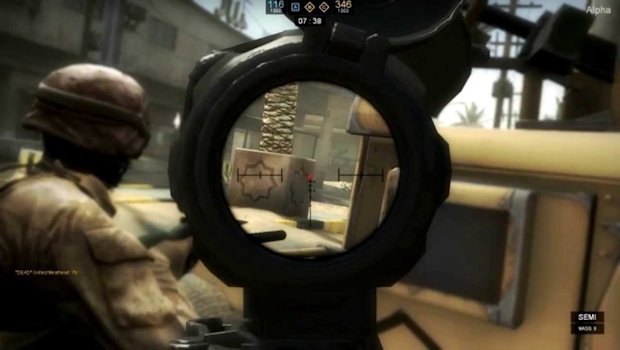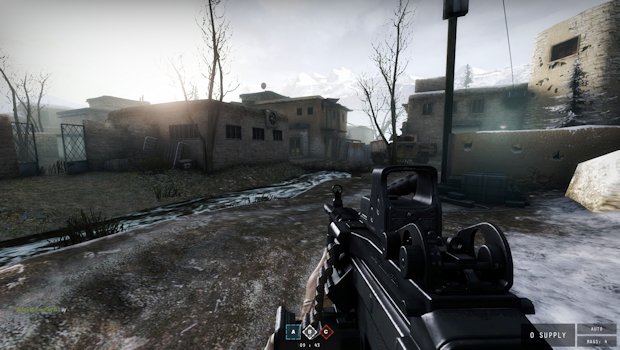The face of multiplayer shooters changed in 2007 with the release of Call of Duty 4: Modern Warfare. Its concepts and gameplay mechanics reinvigorated the genre and made FPS bigger than it had ever been. Modern Warfare also had the side effect of making multiplayer shooters a casual affair, which itself had the side effect of turning a contingent of people off from the genre because it was “too easy”, or “required no skill”, or “filled with 11 year old assholes” (choose your poison). These players that fled the popular multiplayer shooter space stuck with their tried-and-true favorites and continued on as if the last seven years did not happen. Recognizing that there was a small, yet devoted base of old-school players, New World Interactive went about refining their popular Source mod, Insurgency, into a fully fledged game that would cater to these players.
After playing seven years of Call of Duty and Battlefield, I felt immediately at home with the modern warfare set in a Middle Eastern setting the game offers up; unfortunately, that familiarity is a bad thing. As my first round started, I ran out following a few teammates. We approached a corner and everybody took up positions, except me. Not understanding what was going on I proceeded to advance like I would in any of the modern military shooters I’ve played over the past half decade and as I rounded the corner, I was shot in the head and died. Then I had to wait until the round ended before I could rejoin the game.
Things got worse in my second round. Still thinking I had this under control, I broke off from my squad and attempted to lone wolf it towards one of the objective markers. I readied my gun and approached the corners more carefully this time. As I rounded a building right before the objective I caught some movement and instantly opened fire. Turns out that was my teammate and I killed him. Worse yet, my firing on him revealed my location to a nearby enemy and he killed me too. And it was back to watching until the round ended.
The game’s learning curve is a kick in the pants to say the least and being as I have a lot of other games to play, I nearly wrote off Insurgency as a game that was not for me. But I decided to give the game’s Cooperative vs. AI mode, Checkpoint, a try and somewhere in the first round of co-op gameplay the game clicked. Playing the co-op mode I noticed for the first time that there was a lot of chatter, more than I ever get in any of the popular modern shooters and it wasn’t a bunch of little kids yelling racist or sexual slurs at each other. These people were attempting to work together and when you partake in that aspect of the game, it works. One of the players took the lead and gave direction on how we should approach the objective and following his orders we did, and then we hit the next one and the next, until we completed the mission.
The co-op experience showcased what Insurgency was and wasn’t. It wasn’t a game I could lone-wolf and it wasn’t a game I could Rambo through either. No, Insurgency was a game that requires patience and teamwork, two things that Call of Duty and Battlefield have done a great job of separating themselves from to appeal to the everyday gamer. Sure, playing as a team in those games results in better outcomes but playing by one’s lonesome can also result in the same outcomes. In Insurgency, not playing as a team is a quick trip to defeat.
The game itself further enhances this team dynamic by forcing players into particular classes during the battle. Each team has different roles to be filled, which vary based on the game mode, and they are picked by players prior to the start of a match. Players have some agency over how they outfit their characters, utilizing a point based loadout system similar to Black Ops 2, but weapons and equipment is tied directly to the class that was selected. For instance some objectives require explosives to destroy but if a teammate that happens to have the C4 is killed enroute to the objective, that win condition is eliminated from the board and eradicating the other team is then the only way to win. This makes class and kit selection very important and coordinating with your team over what role to play can be another key to success or failure.
For as fun as it is to play Insurgency with a team of players willing to work together, there are still times when you won’t be matched with players that understand or care about how the game is to be played. More than once I encountered players more concerned with keeping a solid kill-death ratio then with helping the team or carrying out objectives. I’ve also been paired with groups of players not willing to play on the team and thinking they can lone-wolf it only to see our team decimated in moments. These instances are not fun but they still happen about 50% of the time I played. These players go against the grain and make the game weaker because of it.
Something else I found that made my enjoyment of the game weaker was the lack of any sort of progression system. While I understand not wanting to warp the playfield by awarding players weapons/attachments/equipment for playing, a simple leveling system would have gone a long way to keeping my personal attention. But then again, I still enjoy playing the games that introduced that system to the mainstream and it kind of flies in the face of what this game is all about. Still, as a fan of shooters and one that likes Insurgency, I think I would devote more time to it if I felt I was progressing towards something, even if it was just making a little bar move a little bit.
Insurgency does what it sets out to do, bringing old-school team style design to a modern military shooter world. It is a game that looks like every other shooter on the market but plays remarkably different from them at the same time. When all of its interlocking components come together it is a fantastic experience and if players have a regular team to play on and get better with, it offers something quite rewarding that rivals the best that Battlefield and Call of Duty have to offer. Unfortunately if you don’t have that, the community is fractured to a point where half of the time the game just isn’t fun and that is a huge knock against an otherwise solidly designed game, a knock that puts Insurgency in a weird bubble that makes it hard to wholeheartedly recommend.
Note: This review was written with material received from the publisher. For more on our review process, please read here.


